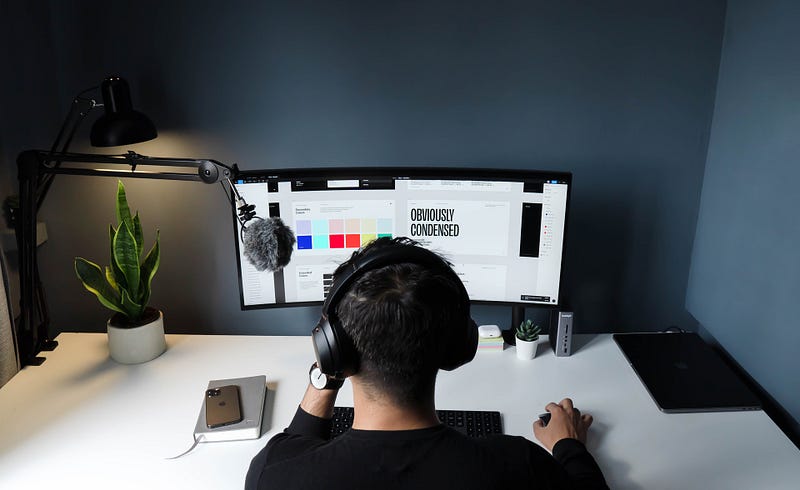# Mastering Productivity: Achieve 70% of Your Work in Just Three Hours
Written on
Chapter 1: Introduction to Productive Work Habits
Many self-employed individuals could significantly reduce their working hours while still achieving exceptional results. As a former instructor in Consistent Performance Coaching, I've witnessed this repeatedly.
You start your day by spending a few minutes scrolling through your phone, checking messages, and responding to emails. Before you know it, it’s time for breakfast or coffee, and then lunch approaches quickly. After a meal, the list of tasks looms over you, causing heightened anxiety. What could have been a productive day turns into a stressful scramble to catch up, leaving you too fatigued to enjoy the rest of your evening.
But there's a better approach.
I begin my workday at 8:30 AM, and by lunchtime, I have already completed 70% of my tasks. By 2:30 PM, I typically wrap up my day, enjoying several free hours before bedtime.
This isn't about some hidden trick; it's about implementing an effective system and utilizing simple tools efficiently. Here's how you can replicate this success.

Chapter 2: The Power of Deep Work
Deep work is the cornerstone of a highly productive day, as emphasized by Cal Newport in his best-selling book on the subject.
Essentially, deep work refers to extended periods of intense, distraction-free focus on tasks that significantly impact your progress. Mastering this concept transforms your work experience from a series of stop-and-go interruptions to a smooth, high-speed journey.
While it sounds straightforward, many freelancers and entrepreneurs struggle with time management.
Highly-focused? Sure, but distractions abound, such as emails, videos, and endless googling.
Uninterrupted? If I had a dollar for every notification or unexpected call, I'd never need to work again.
Moving the needle? Unfortunately, many prioritize tasks that feel rewarding over those that truly matter, leading to busyness without substantive progress.
Let’s shift your focus to mastering deep work, allowing you to tackle tasks with the precision of a bullet train cutting through fresh snow.
Video Description: In this video, discover how a self-employed single mom organizes her week to enhance productivity and manage her time effectively.
Chapter 3: Preparing for Success
“Give me six hours to chop down a tree, and I will spend the first four sharpening the axe.” — Abraham Lincoln.
Deep work is solely about execution. Preparation is critical—if you find yourself constantly having to adjust during your tasks, you'll waste precious time.
When I write, I need to maintain my flow without interruptions to search for information. Switching between planning and execution leads to productivity loss. Focus on executing your tasks, and here's how to be ready when it matters most.
Claim Your Time: Time is your most precious asset. Yet, it’s often given away carelessly—chats, calls, and casual scrolling can quickly consume hours. If you don’t take control of your time, others will.
Establish a time block for deep work, preferably in the early morning before distractions arise. Plan for approximately three hours, allowing for brief breaks, and defend this block fiercely.
Communicate Your Boundaries: When I first started working from home, others assumed I was available for casual conversations. It’s essential to communicate that your deep work is vital to your business. Politely convey your need for uninterrupted time:
“My deep work block is essential, and interruptions can significantly hinder my productivity. Let’s connect later unless it’s urgent.”
Repeating this will help others respect your boundaries.
Video Description: This video presents four habits essential for achieving a cozy work-life balance, especially for self-employed artists.
Chapter 4: Identifying Key Tasks
Next, focus on your One Thing (OT) and Most Important Tasks (MITs).
The concept of your OT comes from the book "The One Thing," which encourages you to identify the single task that, if completed, would make everything else easier. My current OT is writing an article daily, ensuring I develop my skills while generating income.
For your MITs, select three key tasks each day that will help you stay focused and productive. Everything else can wait.
Finally, plan your next day at the end of your current workday. Knowing what you need to tackle saves mental energy when the morning arrives.

Chapter 5: Maximizing Your Productivity Hours
Drawing inspiration from my childhood fascination with Formula 1 racing, I apply similar principles to optimize my work hours.
Two crucial factors influence a car's speed: the vehicle's performance and minimizing interruptions.
To achieve peak productivity, you need both laser focus and the elimination of distractions.
Creating Laser Focus: I've developed several techniques that help lock me into my work, akin to a prisoner's confinement.
- BRAC Cycle: Work in 90-minute intervals followed by 10-minute breaks to align with your natural rhythm.
- Pomodoro Technique: If you struggle with concentration, try 25-minute work blocks with 5-minute breaks.
- Binaural Beats: Listening to specific sound frequencies can enhance focus.
- Flow Ritual: Establish a morning routine that signals your brain to enter work mode.
Minimizing Distractions: Interruptions can severely hinder productivity. It takes an average of 23 minutes to regain focus after an interruption. Here’s how to stay on track:
- Disable all notifications on devices.
- Use noise-canceling headphones to block out distracting sounds.
- Keep your phone’s Wi-Fi off and out of sight to avoid temptations.
- Employ app blockers to maintain focus.
- Use a brain dump to quickly capture ideas without losing your train of thought.
Follow these strategies to enhance your focus and diminish distractions, leading to unprecedented productivity.

Chapter 6: Efficiently Managing Minor Tasks
While it’s easy to overlook smaller tasks, they can pile up if neglected. As a self-employed individual, consider blocking time to address these responsibilities effectively.
Batching Technique: Group similar tasks to minimize the time lost in transitions. For example, handle emails in one sitting using the Inbox Zero method, dedicate time weekly for research, and manage administrative duties bi-weekly.
Summary for Enhanced Productivity:
Time is flexible. Each task can take varying amounts of time based on your focus and approach. If you aim to accomplish 70% of your work in three hours, adhere to these guidelines:
- Prepare thoroughly.
- Block time for deep work.
- Clearly communicate boundaries.
- Plan your following day.
- Maintain laser focus and eliminate distractions.
By implementing these strategies, you can achieve remarkable productivity while ensuring a balanced life—what truly matters in the long run.
If you find value in my insights, consider joining my Medium membership for exclusive content. Together, we can empower each other to lead fulfilling lives true to our authentic selves.